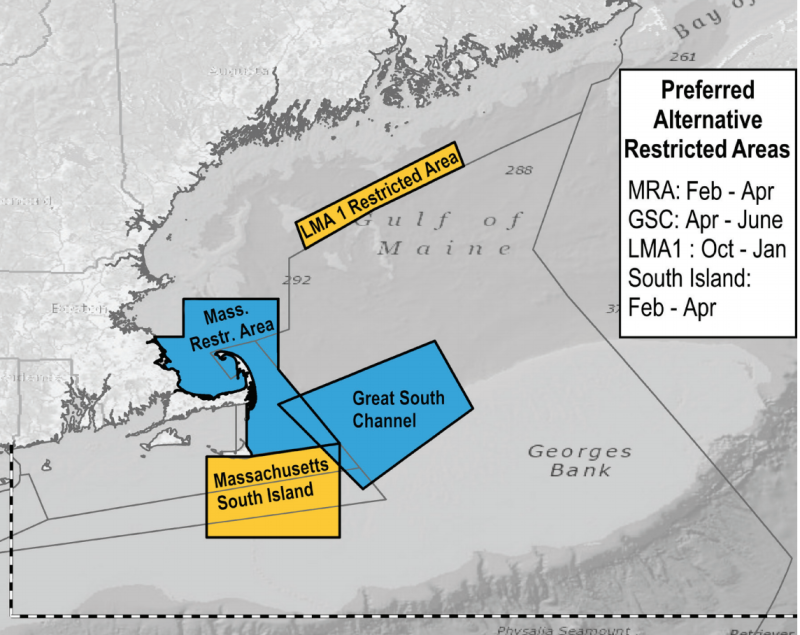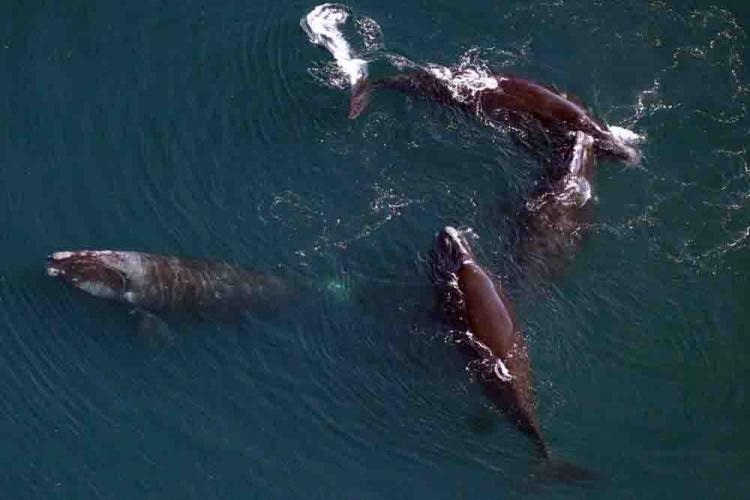The National Marine Fisheries Service released its latest plan to protect endangered northern right whales from lobster fishing gear entanglement – a suite of changes that include new area restrictions, modifying gear to add weak rope into buoy lines and a new system of state-specific gear markings.
The new package of changes to the Atlantic Large Whale Take Reduction Plan, published New Year’s Eve in the Federal Register, is NMFS’ bid to satisfy a federal court ruling that the agency must do more by May 31, 2021 to protect the East Coast right whale population, now estimated to number fewer than 400 animals and less than 100 breeding females.
The proposed rules seek to reduce the number of vertical lines in the lobster and Jonah crab fisheries by requiring fishermen to fit more of their traps between buoy lines and add weak insertions or weak rope into buoy lines, so whales have a better chance of breaking free of entanglement.
Existing seasonal restricted areas would be closed to buoy lines at times when whales are migrating, and exemptions allowed for so-called ropeless or pop-up gear, to incentivize the industry and partners to “accelerate research and development of ropeless fishing methods so that in the future, commercial fishing using ropeless technology can be used instead of seasonal closures to allow trap/pot fishing while protecting right whales,” NMFS administrator Chris Oliver said in announcing the draft rules.

A new system of state-specific marking colors would be introduced – purple for Maine, yellow for New Hampshire, red for Massachusetts and silver/gray for Rhode Island. The specified number and locations markings on lines would be increased.
According to NMFS, of gear that has been recovered and analyzed after entanglements “40 percent has been attributed to U.S. fisheries and 40 percent to Canadian fisheries. The remainder of the recovered gear was unmarked and could not be identified to a fishery or location.“
Advocates for the Maine lobster fishery say the last known entanglement of a right whale in Maine lobster gear took place in 2002, and since then the state’s fleet has taken proactive steps to help establish new whale conservation measures.
Vessel strikes are a leading cause of whale mortality, and Oliver said his agency is also focused on that aspect.
“We will continue our work to reduce the risks posed by vessel strikes in U.S. waters, as well as to collaborate with Fisheries and Oceans Canada and Transport Canada on all matters related to the transboundary reduction of vessel strike and entanglement mortalities and serious injuries of North Atlantic right whales.”
A public comment period is now open until March 1 on the rule changes and an accompanying draft environmental impact statement, with online virtual information sessions scheduled in January to be followed by online public hearings in February.
The first information session Jan. 13 will focus on Massachusetts and New Hampshire, followed by a Jan. 19 online meeting for southern Maine and one Jan. 20 for northern Maine.
“These proposed modifications will affect about 2,500 lobster trap/pot vessels that will have to make changes to the way they fish,” according to Oliver. “The material and labor costs caused by the proposed rule in the first year are estimated to be $7 million to $15.4 million spread out among the fishery that last year generated $485 million in fishing revenue in Maine alone.
“As always, we are looking for ways to support fishermen as they transition to these new requirements, as our goal is to have both a thriving trap/pot fishery and a healthy population of right whales.”
The proposed changes are in response to an April 2020 ruling by U.S. District Court Judge James E. Boasberg that found the lobster fishery was violating the federal Endangered Species Act and that NMFS must do more to protect right whales. The agency says its plan now is estimated to reduce potential whales encounters with gear by 60 percent.
Boasberg found in favor of environmental groups that had sued NMFS, but in August also granted the agency a nine-month reprieve to figure out a response plan.
The Maine Lobstermen’s Association had just begun reviewing the agency’s proposal after its release to stakeholders Wednesday morning, said Patrice McCarron, the association’s executive director.
“We have been anxiously awaiting the release of these draft whale rules since the summer. In April, a federal judge found that the National Marine Fisheries Service was in violation of the Endangered Species Act and the court is requiring that new whale rules be finalized by May to ensure the continued operation of the lobster fishery,” the group said in a prepared statement.
“The MLA now begins the difficult work of reviewing this draft rule to ensure that the proposals will actually aid the recovery of right whales and that these rules do not risk the safety of our lobstermen at sea or the economic lifeline that the Maine lobster industry provides to our coastal communities.”
Environmental groups were likewise sifting through the rule proposal and the 300-plus pages of the environmental impact statement.
“NOAA Fisheries' North Atlantic right whale numbers are significantly lower than the estimate on which the proposed rule is based,” said Jane Davenport, senior attorney for Defenders of Wildlife, in a statement issued by the group. “Unless NOAA Fisheries starts relying on up-to-date data, this rule will be far too little, far too late to prevent the species from going extinct within our lifetime.”
In his statement Wednesday Oliver credited a NMFS task force and its advisors for coming up with the newest attempt to reduce dangers to whales.
“Developing these proposed modifications was challenging for everyone involved,” said Oliver. “On behalf of the agency, I want to thank the 61-member Atlantic Large Whale Take Reduction Team, including the 18 fishermen and fishing industry representatives on the team, for their many hours of time spent developing the recommendations on which these proposed modifications are based.”
Next up for the team during 2021 will be recommending risk-reduction methods for gears in other East Coast trap, pot and gillnet fisheries throughout the whales’ migrating range.







